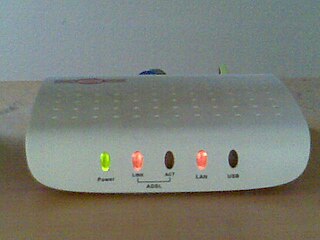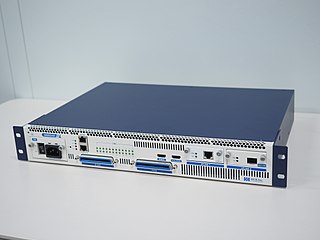Digital subscriber line is a family of technologies that are used to transmit digital data over telephone lines. In telecommunications marketing, the term DSL is widely understood to mean asymmetric digital subscriber line (ADSL), the most commonly installed DSL technology, for Internet access.
A symmetric digital subscriber line (SDSL) is a digital subscriber line (DSL) that transmits digital data over the copper wires of the telephone network, where the bandwidth in the downstream direction, from the network to the subscriber, is identical to the bandwidth in the upstream direction, from the subscriber to the network. This symmetric bandwidth can be considered to be the opposite of the asymmetric bandwidth offered by asymmetric digital subscriber line (ADSL) technologies, where the upstream bandwidth is lower than the downstream bandwidth. SDSL is generally marketed at business customers, while ADSL is marketed at private as well as business customers.
Very high-speed digital subscriber line (VDSL) and very high-speed digital subscriber line 2 (VDSL2) are digital subscriber line (DSL) technologies providing data transmission faster than the earlier standards of asymmetric digital subscriber line (ADSL) G.992.1, G.992.3 (ADSL2) and G.992.5 (ADSL2+).

A digital subscriber line access multiplexer is a network device, often located in telephone exchanges, that connects multiple customer digital subscriber line (DSL) interfaces to a high-speed digital communications channel using multiplexing techniques. Its cable internet (DOCSIS) counterpart is the cable modem termination system.
Data Over Cable Service Interface Specification (DOCSIS) is an international telecommunications standard that permits the addition of high-bandwidth data transfer to an existing cable television (CATV) system. It is used by many cable television operators to provide cable Internet access over their existing hybrid fiber-coaxial (HFC) infrastructure.
In telecommunications, ITU-T G.992.1 is an ITU standard for ADSL using discrete multitone modulation (DMT). G.dmt full-rate ADSL expands the usable bandwidth of existing copper telephone lines, delivering high-speed data communications at rates up to 8 Mbit/s downstream and 1.3 Mbit/s upstream.
Rate-adaptive digital subscriber line (RADSL) is a pre-standard asymmetric digital subscriber line (ADSL) solution. RADSL was introduced as proprietary technology by AT&T Paradyne, later GlobeSpan Technologies Inc., in June 1996. In September 1999, RADSL technology was formally described by ANSI in T1.TR.59-1999. RADSL supports downstream data rates of up to approximately 8 Mbit/s, upstream data rates up to approximately 1 Mbit/s, and can coexist with POTS voice on the same line.
ANSI T1.413 is a technical standard that defines the requirements for the single asymmetric digital subscriber line (ADSL) for the interface between the telecommunications network and the customer installation in terms of their interaction and electrical characteristics. ADSL allows the provision of voiceband services including plain old telephone service (POTS) and data services up to 56 kbit/s, and a variety of digital channels. In the direction from the network to the customer premises (downstream), the digital bearer channels may consist of full-duplex low-speed bearer channels and simpler high-speed bearer channels; in the other (upstream) direction, only low-speed bearer channels are provided.
Carrierless amplitude phase modulation (CAP) is a variant of quadrature amplitude modulation (QAM). Instead of modulating the amplitude of two carrier waves, CAP generates a QAM signal by combining two PAM signals filtered through two filters designed so that their impulse responses form a Hilbert pair. If the impulse responses of the two filters are chosen as sine and a cosine, the only mathematical difference between QAM and CAP waveforms is that the phase of the carrier is reset at the beginning of each symbol. If the carrier frequency and symbol rates are similar, the main advantage of CAP over QAM is simpler implementation. The modulation of the baseband signal with the quadrature carriers is not necessary with CAP, because it is part of the transmit pulse.
In telecommunications, ITU G.992.2 is an ITU standard for ADSL using discrete multitone modulation. G.lite does not strictly require the use of DSL filters, but like all variants of ADSL generally functions better with splitters.

ITU G.992.3 is an ITU standard, also referred to as ADSL2 or G.dmt.bis. It optionally extends the capability of basic ADSL in data rates to 12 Mbit/s downstream and, depending on Annex version, up to 3.5 Mbit/s upstream. ADSL2 uses the same bandwidth as ADSL but achieves higher throughput via improved modulation techniques. Actual speeds may decrease depending on line quality; usually the most significant factor in line quality is the distance from the DSLAM to the customer's equipment.

Be Unlimited was an Internet service provider in the United Kingdom between 2004 and 2014. Initially founded as an independent company by Boris Ivanovic and Dana Tobak in 2005, it was bought by Spanish group Telefónica Europe in 2006 before being sold on to BSkyB in March 2013 in an agreement which saw BSkyB buy the fixed telephone line and broadband business of Telefónica Europe which at the time traded under the O2 and BE brands. The deal saw BSkyB agree to pay £180 million initially, followed by a further £20 million after all customers had been transferred to Sky's existing business. The sale was subject to regulatory approval in April 2013, and was subsequently approved by the Office of Fair Trading on 16 May 2013.

A digital subscriber line (DSL) modem is a device used to connect a computer or router to a telephone line which provides the digital subscriber line (DSL) service for connection to the Internet, which is often called DSL broadband. The modem connects to a single computer or router, through an Ethernet port, USB port, or is installed in a computer PCI slot.

Annex M is an optional specification in ITU-T recommendations G.992.3 (ADSL2) and G.992.5 (ADSL2+), also referred to as ADSL2 M and ADSL2+ M. This specification extends the capability of commonly deployed Annex A by more than doubling the number of upstream bits. The data rates can be as high as 12 or 24 Mbit/s downstream and 3 Mbit/s upstream depending on the distance from the DSLAM to the customer's premises.

A DSL loop extender is a device that a telephone company can place between subscriber premises equipment and central office interfaces to extend the distance and increase the channel capacity of digital subscriber line (DSL) connections. ADSL repeaters are deployed by rural telephone companies trying to provide rural Internet service to farms and small towns where it is impractical to place the DSLAM closer to the subscriber. Typical distance improvements with a loop extender are shown in the diagram below, with rate in megabits per second and distance in thousands of feet.

Annex J is a specification in ITU-T Recommendations G.992.3 and G.992.5 for all digital mode ADSL with improved spectral compatibility with ADSL over ISDN, which means that it is a type of naked DSL which will not disturb existing Annex B ADSL services in the same cable binder.

Asymmetric digital subscriber line (ADSL) is a type of digital subscriber line (DSL) technology, a data communications technology that enables faster data transmission over copper telephone lines than a conventional voiceband modem can provide. ADSL differs from the less common symmetric digital subscriber line (SDSL). In ADSL, bandwidth and bit rate are said to be asymmetric, meaning greater toward the customer premises (downstream) than the reverse (upstream). Providers usually market ADSL as an Internet access service primarily for downloading content from the Internet, but not for serving content accessed by others.
ITU G.992.4 is a standard for splitterless ADSL2 with data rate mandatory capability reduced to 1.536 Mbit/s downstream and 512 kbit/s upstream. It is also referred to as G.lite.bis.

G.fast is a digital subscriber line (DSL) protocol standard for local loops shorter than 500 meters, with performance targets between 100 Mbit/s and 1 Gbit/s, depending on loop length. High speeds are only achieved over very short loops. Although G.fast was initially designed for loops shorter than 250 meters, Sckipio in early 2015 demonstrated G.fast delivering speeds over 100 Mbit/s at nearly 500 meters and the EU announced a research project.










